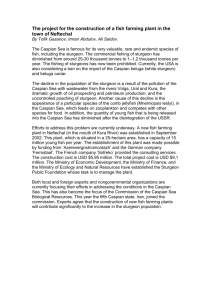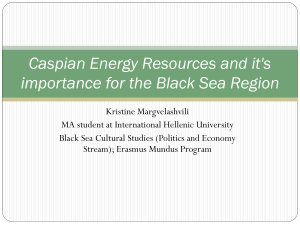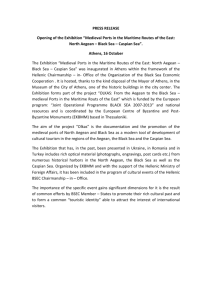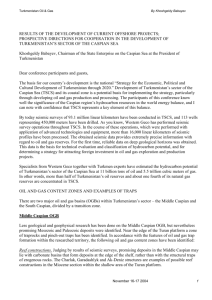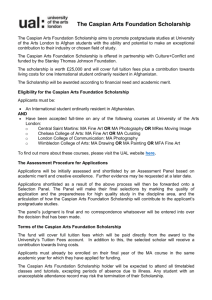Enviromental rights campaign in
advertisement
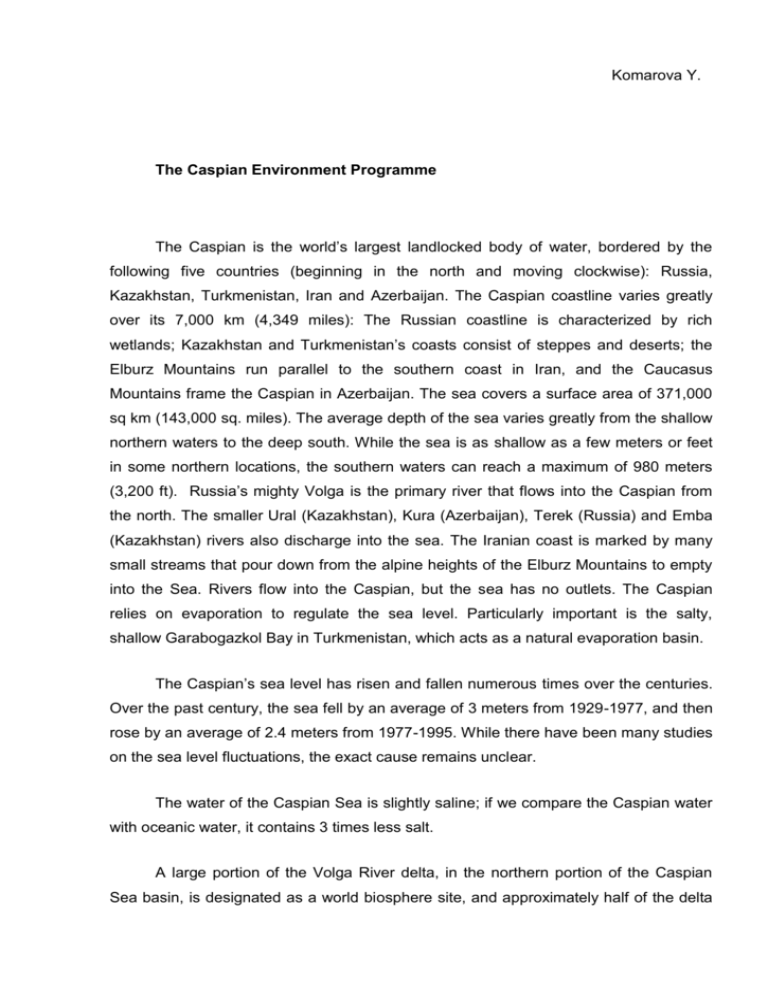
Komarova Y. The Caspian Environment Programme The Caspian is the world’s largest landlocked body of water, bordered by the following five countries (beginning in the north and moving clockwise): Russia, Kazakhstan, Turkmenistan, Iran and Azerbaijan. The Caspian coastline varies greatly over its 7,000 km (4,349 miles): The Russian coastline is characterized by rich wetlands; Kazakhstan and Turkmenistan’s coasts consist of steppes and deserts; the Elburz Mountains run parallel to the southern coast in Iran, and the Caucasus Mountains frame the Caspian in Azerbaijan. The sea covers a surface area of 371,000 sq km (143,000 sq. miles). The average depth of the sea varies greatly from the shallow northern waters to the deep south. While the sea is as shallow as a few meters or feet in some northern locations, the southern waters can reach a maximum of 980 meters (3,200 ft). Russia’s mighty Volga is the primary river that flows into the Caspian from the north. The smaller Ural (Kazakhstan), Kura (Azerbaijan), Terek (Russia) and Emba (Kazakhstan) rivers also discharge into the sea. The Iranian coast is marked by many small streams that pour down from the alpine heights of the Elburz Mountains to empty into the Sea. Rivers flow into the Caspian, but the sea has no outlets. The Caspian relies on evaporation to regulate the sea level. Particularly important is the salty, shallow Garabogazkol Bay in Turkmenistan, which acts as a natural evaporation basin. The Caspian’s sea level has risen and fallen numerous times over the centuries. Over the past century, the sea fell by an average of 3 meters from 1929-1977, and then rose by an average of 2.4 meters from 1977-1995. While there have been many studies on the sea level fluctuations, the exact cause remains unclear. The water of the Caspian Sea is slightly saline; if we compare the Caspian water with oceanic water, it contains 3 times less salt. A large portion of the Volga River delta, in the northern portion of the Caspian Sea basin, is designated as a world biosphere site, and approximately half of the delta consists of wetlands protected by the Ramsar Convention on Wetlands. The Astrakhan Biosphere Reserve, located about 2 hours by car from the city of Astrakhan, serves as a filter on the northern shores of the Caspian Sea, providing a strategic stopover location for East-African, Mediterranean and Central Asian waterfowl migration routes. Millions of birds from dozens of species use these globally significant migration paths. Birds flying from western Africa towards the northeastern portion of Siberia, and from the Arctic to eastern Africa and India, depend on the wetlands of this region. During the spring and summer, waterfowl number at 7 million and 19 million, respectively. In the summer, the delta is home to a minimum of 400,000 ducks. In the winter, hundreds of thousands of ducks, swans and coots inhabit the area. During the mating season, the region hosts approximately 36,000 pairs of Cormorants, 5,500 pairs of Great White Herons, 1,800 pairs of Glossy Ibis, 280 pairs of Spoonbills, 7,000 pairs of Mute Swans, and as many as 130,000 pairs of Common Coots. In all, more than 280 bird species are found in the lower Volga region alone. In addition to birds, the Caspian boasts a rich and varied fish life with over 100 species and subspecies. Approximately 40 percent of these species have commercial value, and over-fishing and pollution have plagued not only the sturgeon, but also smaller fish including sprat, salmon, and certain types of shad. The Caspian Sea basin is home to many endemic species including endangered animals found in the International Union for Conservation of Nature and Natural Resources (IUCN) Red List of Threatened Species. Most well known are the four Caspian sturgeons: the Beluga Sturgeon, Sevruga, Sterlet and Russian Sturgeon, which are at critically low population levels and are threatened by poaching and dangerous levels of pollution. While the Caspian Sea provides 90 percent of the world's caviar production, some experts estimate that if more stringent protection measures are not enforced in the nearest future, the world risks extinction of the Beluga Sturgeon, a species that dates back to the age of the dinosaurs. Among the other at-risk animals is the Caspian Seal, an endemic species and the Sea's sole mammal. Exposure to toxins in the Caspian Sea, which have reached capacity levels, has weakened the immune systems of the seal, causing massive die-offs in the summers of 2000 and 2002, when tens of thousands of seals washed up on the shores of the Caspian Sea. The Caspian faces a series of environmental challenges. These challenges vary in their nature and the degree of threat they pose to the Caspian environment. The Caspian Sea is rich in marine fish of commercial value. The Sea is world famous due to the presence of a unique specie of sturgeon which is of commercial value due to its black caviar and very tasty meat. At its peak, the Caspian supplied more than 80% of the world’s sturgeon stock. These fish species are now on the verge of extinction due to reduction of reproduction grounds, overfishing and water pollution by pesticides, heavy metals and oil products. While fishing methods have clearly become more efficient and overfishing has occurred, one of the most severe threat to the sturgeon and other anadromous species is thought to arise from the construction of numerous dams on the Volga and Kura rivers. These dams bar fish from their primary spawning areas. Due to high levels of water pollution, sturgeons suffer from various diseases such as hepatoxical hypoxiya (muscle blistering). Poaching has dramatically increased during recent years and is thought to be among the main causes for the population decline of the sturgeon. The past 50 years has witnessed introduction of many species into the Caspian, some intentionally and some accidentally. An example of intentional introduction is the Azola, which was introduced into the coastal lagoons of Iran as a fodder for cattle and now chokes many of the waterways on the Iranian coasts and has created a shift in the coastal ecosystems. Since the Caspian is an enclosed sea, it has limited carrying capacity compared to other bodies of water. Pollution entering the Caspian is either biogeochemically altered or remains in the Sea for years with none escaping; dilution is limited from external bufferingwaters. Due to the special circulation patterns of enclosed seas, pollution entering the Caspian from the Volga and other major rivers is ultimately distributed through the Sea and its sediments. Limited oil and diesel is occasionally shipped across the Caspian Sea by an aging fleet of small (less than 5,000-ton) tankers and the ports have less than adequate reception and storage facilities. The risk of a spill during transport or during storage is considerable as evidenced by the Mercury incident in 2002 during which a vessel carrying train-car loads of crude oil from Aktau to Baku capsized killing most of the crew and spilling some oil into the sea The Volga River, the largest in Europe, drains 20% of the European land area and is the source of 80% of the Caspian’s freshwater inflow. Its overall contribution to the Caspian may have diminished somewhat over the years due to extensive dam construction. Its lower reaches are heavily developed with numerous unregulated releases of chemical and biological pollutants. Although existing data is sparse and of questionable quality, there is ample evidence to suggest that the Volga is one of the principal sources of transboundary contaminants into the Caspian. The Caspian basin is rich in commercially developable hydrocarbon deposits. There are significant numbers of oil and gas producing industries and new exploration activity is under way. Oil and oil products generate constant traffic that has been estimated to total approximately 10,000 shipping movements annually. The magnitude of oil and gas extraction and transport activity thus constitutes a risk to water quality. Underwater oil and gas pipelines have been constructed or proposed, increasing potential environmental threats. Commercial activity (fishing fleets, passenger, dry goods and other cargo traffic) utilizes the Caspian en route to the Black Sea or the Baltic via the Volga-Don canal system. This combined traffic has a number of possible impacts on the Caspian's environmental integrity. For example, the Volga-Don connection poses a threat in the form of introduction of exotic species through ballast waters inter alia, and stringent measures may be needed to prevent this threat. The Caspian region is subject to unsustainable coastal area development caused by different factors which impact the human population, the environment and the amenities. The coastal landscapes and habitats are damaged by a variety of natural and human-made factors. Natural factors include sea water level fluctuations, earthquakes and climate change. Human-made causes include desertification deforestation, regulation of rivers, urbanization and industrial development, improperly planned agricultural, aquaculture and recreational development and land-based and sea-based pollution. The Caspian Environment Programme (CEP) is a regional umbrella programme developed for and by the five Caspian Littoral States, Azerbaijan, I.R. Iran, Kazakhstan, Russia and Turkmenistan, aiming to halt the deterioration of environmental conditions of the Caspian Sea and to promote sustainable development in the area. The need for joint protection and management of the Caspian environment and its resources has been an ongoing issue for the Caspian States. In particular, since the collapse of the Soviet Union (1991) there has been heightened awareness of such a need. So, the CEP born out of a long desire for regional cooperation, expressed through a number of regional agreements since 1991: A draft Convention on the Conservation and Utilisation of Bioresources of the Caspian; The Baku Resolution, June, 1991; The Tehran Communique, October 1992; The Astrakhan Communique, October 1993; The Declaration on Environmental Cooperation in the Caspian, Almaty, May 1994; The Protocol of the Meeting on Programmes for the Protection of the Environment in the Caspian Region, Almaty, 1994; The report of the joint meeting of the task force and TDA experts, Almaty, 1997; National reports on the state of the Caspian, 1998; Report of TDA Experts Meeting (including Framework TDA), Tehran, April, 1998; and The decisions of the First meeting of the Interim Steering Committee of the CEP, Ramsar, 1998. During the Ramsar meeting held in the Islamic Republic of Iran, in May 1998, the CEP was officially launched. The CEP aims at Sustainable development of the Caspian environment, including living resources and water quality, protecting human health and ecological integrity for the sake of future generations. The CEP's mission is to assist the Caspian littoral states to achieve the goal of environmentally sustainable development and management of the Caspian environment for the sake of long-term benefit for the Caspian inhabitants. The CEP is a programme for and from the five Caspian Littoral States, Azerbaijan, Iran, Kazakhstan, Russia and Turkmenistan aiming to halt the deterioration of environmental conditions of the Caspian Sea and to promote sustainable development in the area. This intergovernmental process is currently being supported by CEP’s International Partners, Global Environmental Facility (GEF), UNDP, World Bank, UNEP and European Union, other international organizations and the private sector, in particular the oil and gas sector. In the first four years, CEP has developed and adopted a Strategic Action Programme (SAP) for the protection and rehabilitation of the Caspian environment in four priority regional environmental concern areas and assisted the littoral states to develop National Caspian Action Plans (NCAPs). The Caspian Environment Programme (CEP) is governed by a Steering Committee composed of representatives, typically at the Ministerial or DeputyMinisterial level, from each of the five Caspian littoral states. In addition, the United Nations Environment Programme (UNEP), the World Bank (WB), The European Union/Technical Assistance to the Commonwealth of Independent States (EU/Tacis), and the United Nations Development Programme (UNDP) are members of the Steering Committee. The Steering Committee is the Governing and Policy-Making body of the CEP. The Steering Committee meets at least once a year in its ordinary meetings, but may hold additional meetings at the request of the Steering Committee Chairman. Representatives of the private sector, public and non-governmental organizations are often invited to participate as observers. The National Focal Point and the National Coordination Structure (NCS) provide coordination at the national level. Overall CEP implementation is under the guidance of the Programme Coordination Unit, led by the Programme Coordinator. The five Regional Advisory Groups (RAG), established to replace the Caspian Regional Thematic Centres that were operational during the first four years of CEP are as follows: - Advisory Group on Biodiversity and Invasive Species - Advisory Group on Fisheries - Advisory Group on Emergency Response - Advisory Group on Pollution - Advisory Group on Sustainable Coastal Development Each littoral state will chair and host one of the Advisory Groups. The Regional Advisory Groups purpose is to assist CEP PCU in concert with the PCU to coordinate its activities in the priority regional environmental concern areas. The Regional Advisory Groups will oversee implementation of the SAP in their specific concern area and, where required, develop specific implementation plans. Through the Regional Advisory Groups the littoral states will contribute to the overall regional coordination of the CEP. During its first four years (July 1998 to October 2002) the CEP has established and prepared the following: A management structure, including a Programme Coordination Unit (PCU) and ten Caspian Regional Thematic Centres Transboundary Diagnostic Analysis (TDA) National Caspian Action Plans (NCAPs) Strategic Action Programme (SAP) Biodiversity Strategy and Action Plan (BSAP) Priority Investment Portfolio Project (PIPP) Draft text of the Framework Convention for the Protection of the Marine Environment of the Caspian Sea Regional Cooperation Plan for Oil Spill Preparedness In November 2003, the five Caspian states, in an unprecedented action, signed the Framework Convention for the Protection of the Marine Environment of the Caspian Sea (further Tehran Convention). This document, eight years in the making, reflects efforts by the governments of Azerbaijan, the Islamic Republic of Iran, Kazakhstan, Russia and Turkmenistan to reach agreement on a regional effort to protect the fragile environment of the Caspian Sea. Facilitated by the United Nations Environment Programme (UNEP) and the Caspian Environment Programme (CEP), the convention was signed in Tehran on November 3, 2003. Over the next two and a half years, the Caspian governments ratified the convention one by one—Turkmenistan in August 2004, Russia in September 2004, Iran in April 2005, Kazakhstan in December 2005, and Azerbaijan in April 2006. The objective of Tehran Convention is the protection of the Caspian environment from all sources of pollution including the protection, preservation, restoration and sustainable and rational use of the living resources of the Caspian Sea. Before the convention entered into force, four protocols were prepared and agreed upon by the Parties to the Convention: 1. Protocol on Biodiversity Conservation 2. Protocol concerning Regional Preparedness, Response and Cooperation in Combating Oil Pollution Incidents 3. Protocol on Environmental Impact Assessments in a Transboundary Context 4. Protocol for the Protection of the Caspian Sea Against Land-Based Sources of Pollution Within the context of the CEP in the Second Phase, the main responsibilities of the five Caspian littoral states will include the following: to contribute to the overall strategic policy and management direction to the CEP through their representation in the Steering Committee; to provide technical and management advice to the CEP through their representation on the Advisory Groups; to provide national policy guidance for the CEP through their National Coordination Structures (NCS) and Inter-sectoral Coordination Groups (ICG); to ensure that policy guidance from the Steering Committee is reflected in national CEP-related policies and programme activities, as appropriate; and to contribute and commit, financially and in kind, to implementation of the National Caspian Action Plans and the Strategic Action Programme. CEP will concentrate efforts in the longer term on the implementation of the adopted NCAPs and SAP and further support to the Framework Convention Process. Implementation of the SAP will be supported by the CEP with the assistance of the International Partners at both the national and regional levels. During SAP implementation it is anticipated that other international agencies will apply to have their projects included under the CEP umbrella and in so doing become full international partners. Currently, there are four projects under the CEP, namely the GEF Phase II Project titled “Towards a Convention and Action Programme for the Protection of the Caspian Sea Environment”, in short “CEP-SAP”; EU/TACIS Sustainable Management of Caspian Fisheries Project; EU/TACIS Sustainable Development of Caspian Coastal Communities Project and EU/TACIS Strategic Action on Caspian Marine and Coastal Environment and Support to the Caspian Sea Framework Convention. The Ecotoxicology Project carried out investigation into toxic contaminant accumulation and related pathology in the Caspian sturgeon, seal and bony fish. Short-term economic interests of all the five concerned countries prevent establishment of international legal standards system of Caspian region environmental safety. Many experts believe that the slowdown in the discussion of environmental issues is a consequence of that the main problem, not determined status of the Caspian Sea, is still not solved. As a result, everyone suffers, and, first of all, a unique natural environment of the region. Implementation of the Caspian Environment Programme is an absolute success of the Caspian region. Due to the Caspian Environment Programme, the ecological security protection work is already started in the region.
